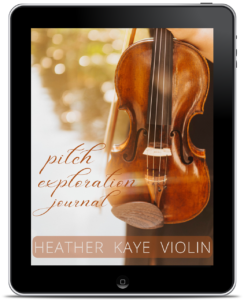How to Play More in Tune on the Violin
Do you struggle with playing in tune on the violin? Are you absolutely hating working with a tuner? In this post, discover 10 tips to help you play more in tune on the violin.
It may seem obvious, but tip number one is to make sure your violin is in tune. It’s not going to be beneficial to practice intonation on an out-of-tune foundation. Also be sure to regularly check it as you’re practicing.
Play more in tune by getting to know the pitches on an individual basis. In this Pitch Exploration Journal, you have journal prompts to help you create a systematic study of the pitches A-G, sharps, flats and intervals.
Suitable for all levels of violinists.
After years of intonation frustration, I decided to take charge of my intonation journey. Obviously what I was doing was not as effective as I wished it to be so I decided to change my approach. I was on my personal quest for the holy grail of perfect intonation. On this quest, I realized that in order to find the holy grail, I needed to retrain my ear as my compass. I learned to listen to pitches differently and realized I needed to hear that each pitch has its own identity ALWAYS no matter where the pitch is played on the instrument.
I Learned to fall in love with the pitches.
I found truth in the in tune pitches and they illuminated my path on my violin journey. Instead of focusing on being out of tune, I was focusing my energy on being in tune. Instead of me going to the note on the instrument – I had the note come to me from the instrument.
You see all the pitches have homes on the instrument and it is a matter of the finger to feel it is coming from that home. It is a very different concept and difficult to explain in words but just explore the idea. Have it sit with you and see if it can change your approach to studying intonation.
Happy Truth Finding:)





I am always a bit confused when it comes to using a tuner or other app/software to check intonation since we have different ways to tune on the Violin depending on circumstances eg equal temperament with a piano, Pythagorean as a soloist, Just intonation? Do we conciously think about these tuning systems each time we play in a different situation or is this something we do naturally?
Sonia, I would first focus on how the pitches affect your body. Where you feel them..what you see..what you think of..play a pitch for a few minutes and really get to know that pitch. Of course when you are playing in an ensemble or with a piano it is absolutely necessary to play in tune with your fellow musicians and in those cases sometimes the perfect pitch does have to be bent a little bit…but don’t get too lost in the analysis..
Great tips. Genuinely helpful. In the past I usually limited my fiddling to C, G, D, A keys. Now I am starting to branch out to F, Bb, Eb, and E. Learning new notes and positions and 2-5th positions. Thank you so much!
You are so welcome Mac! Really excited you found this to be helpful in your violin journey.